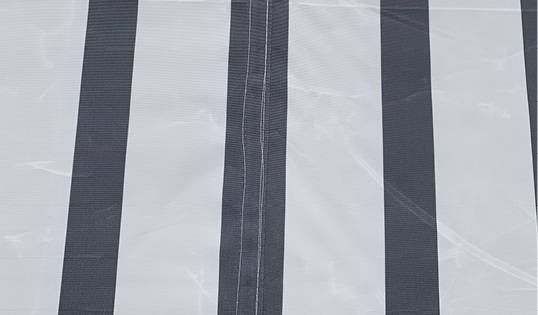Cheap awnings in the test: Disaster from Aldi
Even cheap models must comply with the standards. The GLASWELT editorial team checked a cheap awning from a discounter – and was horrified. Read for yourself what happened.
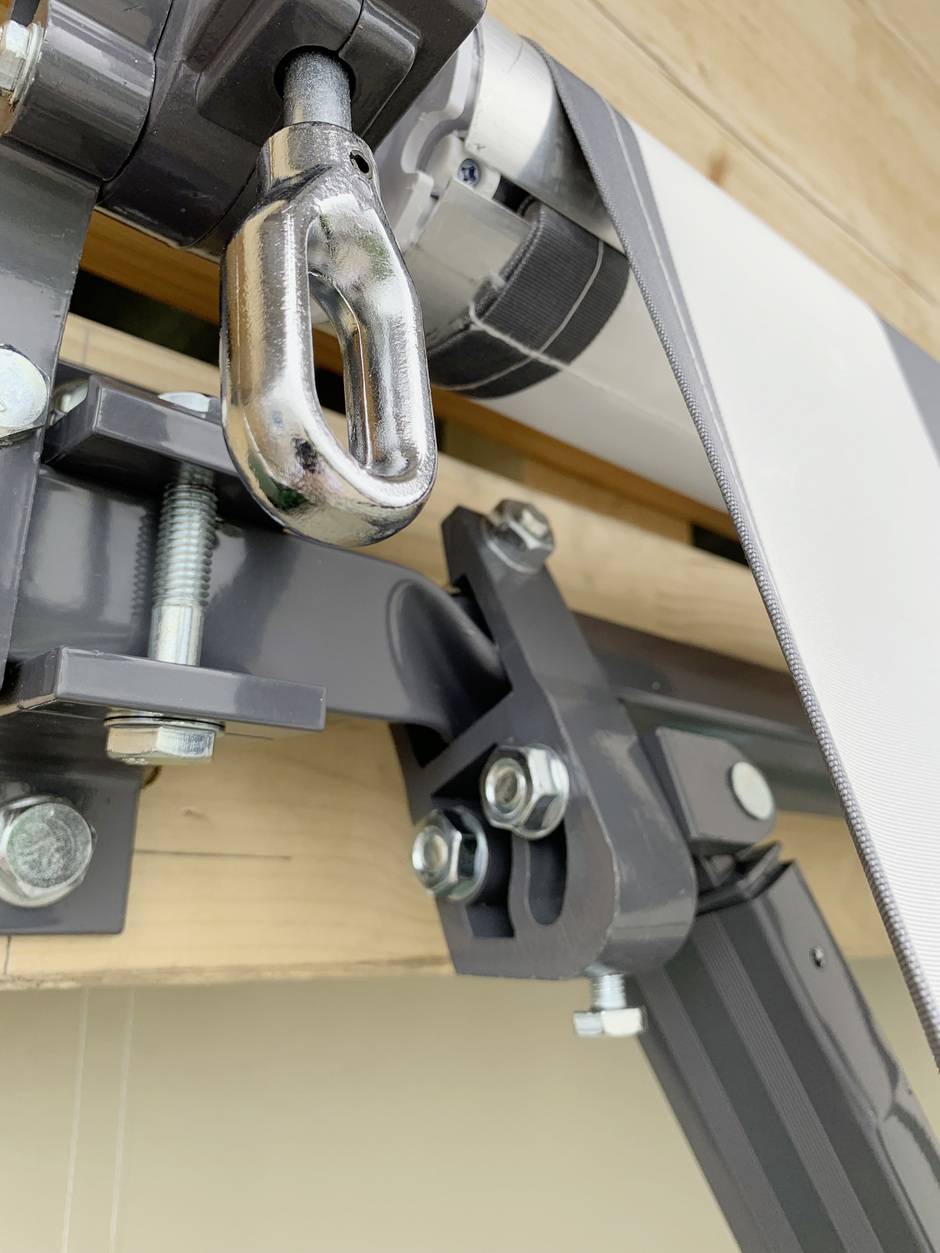
Whereas up to now it was the Internet and DIY stores that saturated the market for cheap awnings, in the latest phase of development the discounters, such as Aldi-Süd in this case, are joining in. What does cheap awning actually mean? We first make it on the price and draw a line here for awnings up to 200 euros for a size up to 3.5 × 2.5 m. Whether cheap, as here with the Aldi awning with a price of 129 euros also means poor quality, we want to test in detail.
Which regulations apply to whom?
It is actually quite simple, because the relevant harmonized awning standard DIN EN 13561 makes very clear specifications on the mandated properties wind with the wind resistance classes . These apply to all awnings placed on the market in the EU, so completely independent of whether it is a large awning manufacturer, a small fabricator or an importer. The decisive factor is that the applicable regulations are complied with. It doesn’t behave quite as strictly, but similar to automobiles. It makes no difference whether the vehicle is from a low-cost supplier, such as a Dacia Logan, or a Mercedes S-Class. Applicable regulations must be observed by all. So the issue of safety has nothing to do with the price of the vehicle. The advantage with the automotive industry is that all vehicles are inspected by the Federal Motor Vehicle Department. And as you saw with the emissions scandal, that’s a powerful tool to check regulations.
In the case of awnings, CE certifications are carried out according to System 4, which means that each manufacturer can carry out these tests themselves. Is that a disadvantage? Yes and no, because on the one hand this offers the clear possibility of manipulation, but on the other hand it also offers the possibility of verification by third parties. A fact that we embrace here.
The test setup: Double is better
To be clear, we performed the tests twice with two individually ordered awnings. Not because we are afraid of Aldi, but because the deformation of the awning was so frightening during the first test that we repeated the test at a second location with a higher mounting position. In the test setup, the test specifications of DIN EN 13561:2009 and DIN EN 1932:2001 were strictly adhered to and tested in several test steps.
The documentation was done in writing, by photos and by videos. The release of the test weights in particular was secured in an unedited video in order to prevent any accusations of manipulation during the test. The nominal test load was calculated using the formula FN = ß × p × L × H. Where for ß = 0.5 (coefficient for conversion of distributed loads to test loads) was used. For p, the test pressure of 70 N/m2 according to wind class 2 of DIN EN 13561:2009 was applied. Since the awnings sold as 3 × 2.5 m were actually only 2.95 × 2.35 m each, the fabric size was determined to be 2.82 × 2.35 m measured. From this, the nominal test load of 23.8 kg in total and, at a safety test pressure of 1.2 p (84 N/m2), a safety wind loadFS of 28.4 kg in total are derived.
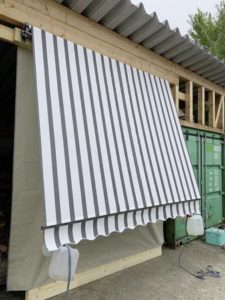
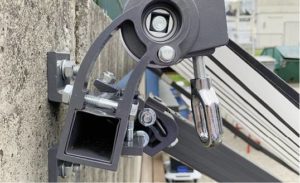
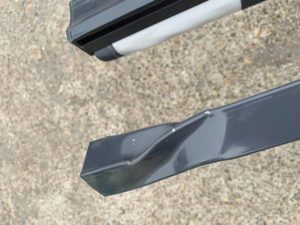
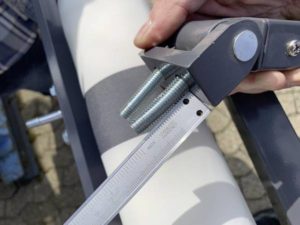
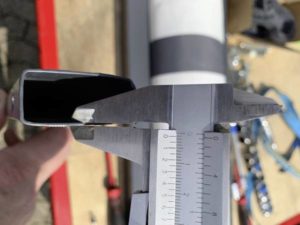
The test result: Maximum deformation
The audit result is relatively simple to describe. Even with the nominal test load, the awning deformed to such an extent that it was no longer usable. The test with the safety wind loadFS produced a deformation of the supporting tube of 85°, which corresponds to a quarter turn. The deformation occurred so quickly that a gust of wind here poses a danger to life and limb for people present below. The awning therefore does not comply with the recognized rules of technology.
User / maintenance manual with many errors
At first glance, the instructions included in the awning box make a solid impression, but this evaporates just as quickly upon closer study. Many imprecise statements string together, a use of the awning in rain and wind, for example, is prohibited several times without giving more precise information on the slope of the awnings or permissible wind speeds. The locking screw of the awning bracket, for example, cannot be inserted from above as described in the drawing and secured from below with a nut and washer, but can only be inserted from below due to the design.
Securing with a washer and nut is not possible in this way because the washer does not fit into the upper groove. If the nut loosens when the awning is in use, the screw may fall out downwards, for example, causing the support tube to slide out of the bracket. On a positive note, the maintenance manual goes into great detail on the subject of maintenance. An interesting detail is the fact that the instructions from the Internet contains an EU Declaration of Conformity, and the instructions enclosed in the awning box does not.
An acceptance protocol or similar is not available, so that the probable end user as the person installing the awning does not realize at all that the permissible wind speed can be significantly reduced when using the awning due to the installation method. Also incomprehensible is the warning that qualified personnel must be used for disassembly and not for assembly.
Fasteners without mind and approval
It becomes extremely dangerous with the enclosed mounting material of the awning. The pseudo-fasteners optically trimmed to „heavy-duty dowels“ are not worth the term dowel at all and are completely unsuitable to securely fasten an awning. This becomes particularly clear in view of the hand-sawed expansion slots in the aluminum sleeve. You won’t find an instruction leaflet with processing instructions or information on load capacities. Only in the use/maintenance manual is there a chapter on fastening the „wall anchors“.
All in all, however, not sufficient and not according to the recognized rules of technology. There is a lack of corresponding ETA approvals for the enclosed fasteners or corresponding notes in the instructions for use when installing in other wall constructions. According to the current legal situation, these are required in any case by the Construction Products Regulation for the attachment of awnings. For the GLASWELT editorial team, this is a reason to talk to the market supervisory authority shortly.
Optical super disaster with the awning cloth
The supplied awnings were each covered with a polyester fabric in white-gray block stripes. Already when unpacking from the protective film in the awning box, very clear creases, folds and handling folds could be identified on the fabric shaft, which were visible in an alarming amount after assembly and the first extension.
If the cloth guidelines of the ITRS/IVRSA are used as a basis here, it could be decided without further testing that the awning supplied does not comply with the recognized rules of technology in this area either. The test of a test strip of the polyester fabric gave the grade unsatisfactory in the weathering test according to ISO 105 B04 (Textiles – Color fastness tests – Part B04: Color fastness to artificial weathering: Xenon arc light) after only 333 hours according to the blue scale. The test has now been extended to 1000 hours in order to better assess further development.
Certifications without sense and reason
Of course, during the inspection of the discount awning, the accompanying documents and the applied CE mark were also checked. Here, due to the mistakes made, it becomes clear very quickly that the acting persons have half-knowledge, but have not understood the standards situation and applicable regulations at all. This is made very clear by the EU declaration of conformity, which was only permissible in its present form until the Construction Products Regulation came into force in 2013. Particularly conspicuous: The declaration of conformity refers to the standard status of DIN EN 13561 from 2015 and the corrigendum from 2017. This shows all the more that one is probably only guided by the publications of the Beuth-Verlag and not by the publications in the European (OJEU) or German Official Journal.
The CE mark attached to the awning arm also shows the 2015 standard status, in addition to wind resistance class 2, the total energy transmittance gtot of 0.32. Both statements would be suitable for legal action, since the declaration of performance and the CE mark required here must be drawn up in accordance with the 2009 version of the standard. Declaration of conformity is not required at all because of the hand crank. Together with the test results, the awning may not carry a CE mark.
Each member state of the EU is obliged to ensure the correct use of the CE marking. In Germany, control should be carried out by the federal states as part of a system of market surveillance coordinated by the DIBt. In addition to consequences under criminal and regulatory law, civil law consequences of an incorrect CE marking are also possible (possibly defect of the construction product). Consequences under competition law in the event of incorrect labeling, such as warning letters, are also possible here. This is also being discussed at the market watch.
Implications for the R+S industry
Do such products as the cheap awning from the discounter Aldi have any impact at all on the overall market. Does the clientele of specialized companies buy such an awning? For the garden or weekend house, perhaps, and that would already be an awning „less“. But there are two much more serious reasons why cheap awnings can affect the overall market.
Firstly, price sensitivity: the end consumer encounters the price of such an awning during his daily shopping at the discount store. Here it was 129 euros. Now comes the comparison to the specialist dealer: at least 1300 euros plus installation, more than ten times. This certainly raises questions. Secondly, it is precisely the CE tests for the awnings, which probably did not take place here for sure. We do not even want to speculate about the proof of a factory production control (WPK). But these are precisely the points why a self-audit under System 4 could be overturned.
This article by Olaf Vögele was first published in GLASWELT 08/2019.

